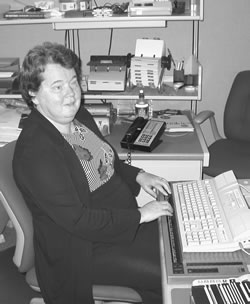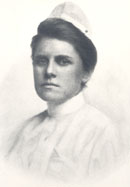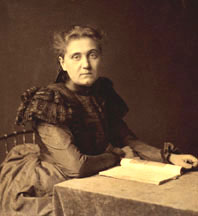As promised, a mid-May edition of the Disability Blogs Roundup. You'd think the job was made easy by
Blogging Against Disablism Day at Diary of a Goldfish--there were something like 117 blogs posting on disablism/ableism on May 1, including
DS,TU. I won't repeat the collection here, but it's definitely worth a browse--it includes two
German-language blogs, and one blog in
Chinese. But no.... in the weeks just before and after BADD 2006, there have still been plenty of interesting posts to make our roundup here, too.
We just passed Mothers' Day in the US, and a few roundup regulars made note: Kristina Chew remembered the "
refrigerator mothers" of autism's past (and present too, sadly--the mother-blaming is far from forgotten); in a lighter vein,
Mark Siegel encountered a Mom screening dates on Match.com (he seems to have passed the Mom's test, anyway).
In the news: The
Gallaudet student protests seem to have ended
for now, but read through the events of recent weeks at
Deaf in the City, or
DeafDC. Mark Siegel (again) and Kristina Chew (again) commented on the case of
Jared Guinther, the
Army recruit who was released from his contract when his autism diagnosis became known; Liz Spikol caught this
Katrina aftermath story, and has been collecting stories about Iraq War
veterans' mental health. And at
Edge-Centric, analysis of the "Story They've All Been Waiting For." Jesse Kaysen at the
Media Circus blog on Ragged Edge found the New York Times story on a "special" ballet class "sticky" (for an alternative reading, check
Croneway's personal response). Oh, and it turns out you can stab your disabled roommate to death in New Zealand, and the judge might believe it was about
mercy.

Disturbing developments: the National Autism Association's controversial new "Butterfly" ad campaign has
Kristina Chew musing on the appeal and danger of fairytales, while AutismDiva calls it "
creepy". The National Library Service has suddenly taken
web-braille offerings
offline--see
Ahistoricality's tale; here's the
Ragged Edge roundup on the topic; and yes, there's a
petition (photo at left shows
Judy Dixon, one of the architects of web-braille).
Angry Gimp and
Chaironwheels are talking about
CILs gone wrong (or at least gone lost under paperwork and funding shortfalls and other pressures). BlindConfidential's been covering the efforts of Apple to patent some audio feedback technology (in a series of posts, starting
here, then
here, then
here, and more
here). And why did the London Times send
Rod Liddle to review Dans le Noir?
Access and travel are perennial subjects here:
GetAroundGuide and
Rolling Rains always have good posts on the subject. Dave found that his detailed planning was too often for naught on his recent holiday in Darwin, because at airlines and hotels, "
people just don’t care about details - even though they appear to." Pretty much the same story in
Albuquerque, it seems: "[Reward] Points are nice, but I’d rather take a shower without having to call someone," explains Katja at Broken Clay. (On the other hand, English blogger
Lisy Babe was delighted with the accessibility of San Francisco on a recent visit.) New blogger
Cheryl at Steps wasn't traveling, just trying to go to an "accessible" theatre that wasn't so accessible after all. And
Katja (again) is curious about the steps in front of a "wheelchair-friendly" two-story model house. (Access hidden in a closed garage isn't exactly "visitable" or welcoming, she notes.) Meanwhile in London, Damon Rose is on
Cinema Watch--keeping track of which theatres are showing which movies with Audio Description.
Then there's the ever-popular genre of unhelpful advice.
Gimp Parade has a newsflash for medical professionals: sometimes disabled people get sick or hurt.
Gimpy Mumpy was told by a physical therapist to try and "Move normal." Someone has an advanced degree and that's the best they can offer?

Wheelchair adventures: Charles Dawson was
fixing up an old wheelchair that apparently once belonged to "Doris"; Sarah reposted Harriet McBryde Johnson's recent NYTimes Magazine essay, "
Wheelchair Unbound";
Sally spent a lovely day at the accessible Salisbury Cathedral (right)--before her van was damaged on the way home, by a hit-and-run (they caught the guy). Ziggi at
Wheelchair Diffusion just says "It's about enough"--people should have chairs that work for them. Seems basic, doesn't it?
Ending on the high notes: Google is rolling out a more accessible
audio CAPTCHA verification scheme;
Blind Chance is beginning its third year as an audio blog; Teri at
Crip Chronicles recommends the
"Helping the Handicapped" photo essay and speech (go have a look, and understand the irony in artist Ju Gosling's title).
Estee Klar is preparing for an
Outsider Art exhibit and lectures in Toronto (outsider art is getting a run in England too, with some
controversy). And be sure to check out Dave Wallace and Mike Seyfang's new podcast, "
The Extraordinary Everyday Lives Show"--it's not exclusively about disability, but that's part of the Australian show's focus.
A final heads-up: The Society for Disability Studies meets in a few weeks in Bethesda; I won't be there, but Eastern bloggers might be. Meanwhile, here's
one presenter's SDS paper, already online.
 Today is the 120th anniversary of the birth of Dorothy Harrison Eustis, born this date in 1886 into a prominent Philadelphia family. Both of her husbands were interested in animal breeding--her first husband experimented with breeding cows for increased milk production, and she ran a dog breeding program in Switzerland with her second husband, selecting for intelligence to train dogs for police, military, border patrol, and similar purposes. Dorothy Eustis learned about German dog training programs to train guides for blind WWI veterans. She wrote about the approach for the Saturday Evening Post in 1927, saying:
Today is the 120th anniversary of the birth of Dorothy Harrison Eustis, born this date in 1886 into a prominent Philadelphia family. Both of her husbands were interested in animal breeding--her first husband experimented with breeding cows for increased milk production, and she ran a dog breeding program in Switzerland with her second husband, selecting for intelligence to train dogs for police, military, border patrol, and similar purposes. Dorothy Eustis learned about German dog training programs to train guides for blind WWI veterans. She wrote about the approach for the Saturday Evening Post in 1927, saying:






